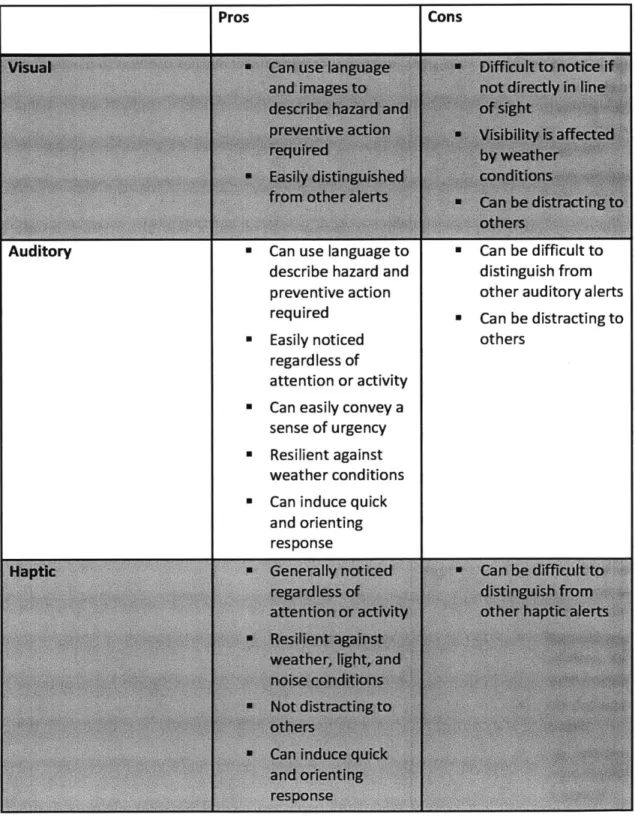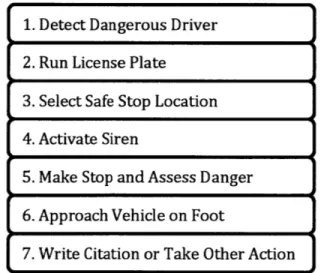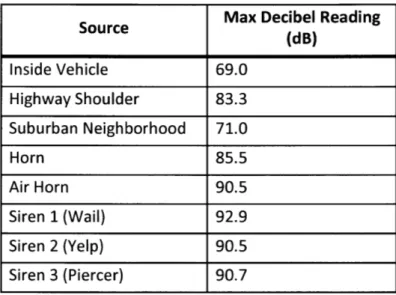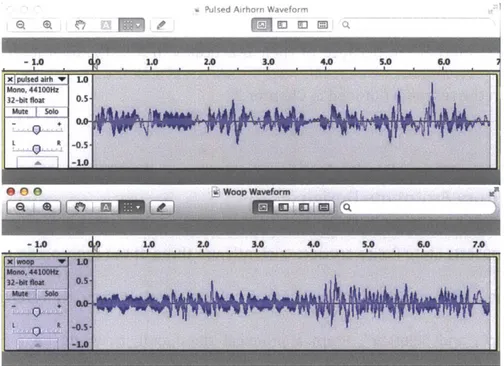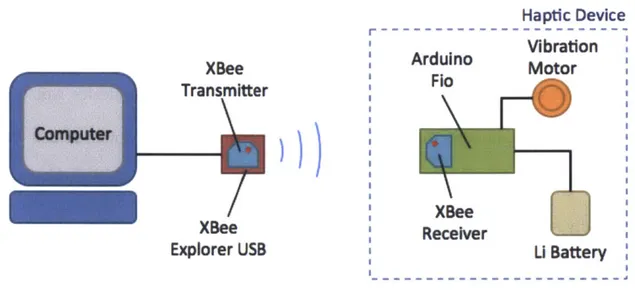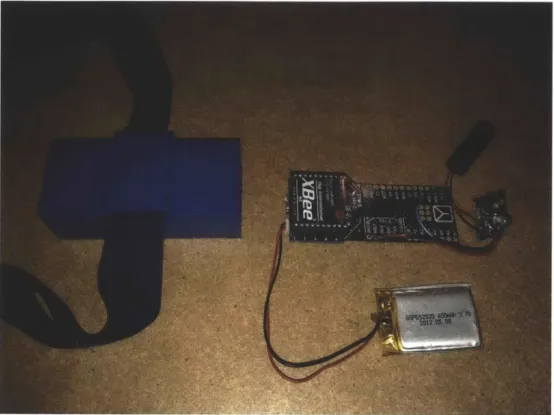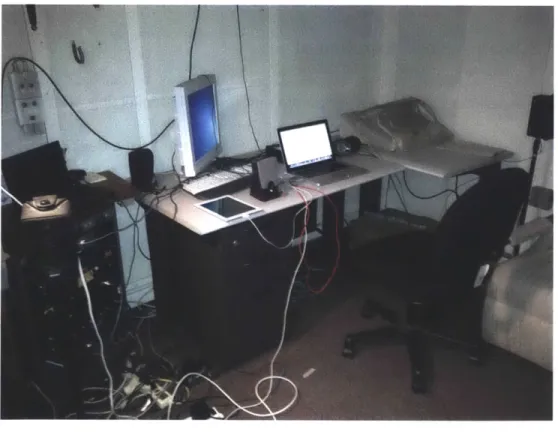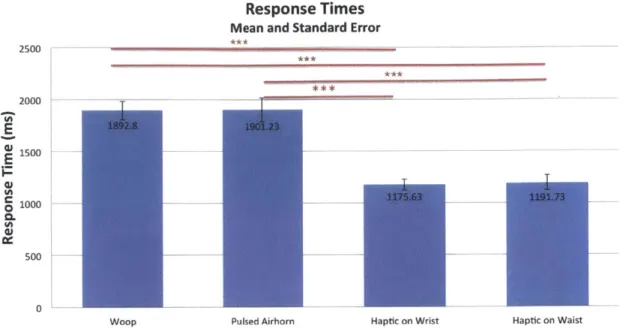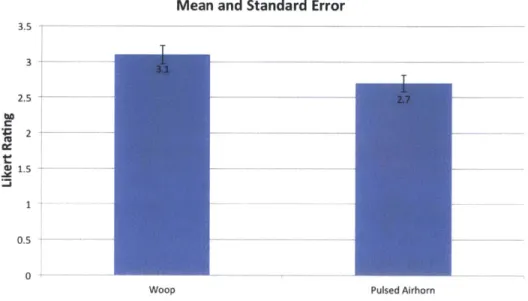Design and Testing of a Roadside Traffic Threat Alerting
Mechanism
By
Pallavi Powale
B.S. Electrical Engineering and Computer Science
Massachusetts Institute of Technology, 2012
Submitted to the Department of Electrical Engineering and Computer
Science
in Partial Fulfillment of the Requirements for the Degree of
Master of Engineering in Electrical Engineering and Computer Science
at the Massachusetts Institute of Technology
May 2013
(U,-Kt
1co
Copyright Massachusetts Institute of Technology.
All rights reserved.
ASSACHUSETTS INSI'mrE
OF TECHNOLOGY
OCT 2
9
2013
LIBRARIES__
Department of Electrical Engineering andCertified by:
Certified by:
Accepted by:
Computer Science May 24, 2013
Mary L. Cummings, Associate Professorf Aeronautics and Astronautics, Th 's'
Sup visor
May2
Erin T. Solovey, Postdoctdal Fellow, Humanon Automation Lab, Thesis Supervisor May 24, 2013
Dennis M. Freeman, Chairman, Masters of Engineering Thesis Committee Author:
Design and Testing of a Roadside Traffic Threat Alerting
Mechanism
By
Pallavi Powale
Submitted May 24, 2013 in Partial Fulfillment of the Requirements for the
Degree of Master of Engineering in Electrical Engineering and Computer
Science
Abstract
Every year, law enforcement officials, emergency personnel, and other workers stopped in traffic outside their vehicles are struck by inattentive drivers. Until now, most efforts to prevent these types of accidents have been geared toward making these at-risk parties more conspicuous to oncoming motorists. In contrast, this work proposes an alerting mechanism designed specifically to induce defensive behavior on the part of the at-risk officers (or other roadside personnel), once a hazardous situation has been detected. The immediate objective of this research was to produce an effective alarm prototype for a high noise, low-light operation environment such as a dimly lit highway shoulder. Based on fieldwork and background research, four such prototypes were engineered and evaluated for user response speed and subjective preference. Two of these alarm prototypes were auditory sirens and two were haptic vibrations, one placed at the waist, and one at the wrist. Haptic vibrations, which we hypothesized would be more salient in a loud and visually stimulating environment, proved to induce statistically significantly faster responses than the auditory alarms and were well received by the user community of State Police. The auditory sirens, however, were perceived as significantly more urgent than the haptic alarms and would be a beneficial addition to the haptic device to add redundancy to the system. Implemented in highway safety systems, the warning system developed through this work has the potential to help save lives.
Thesis Supervisor: Mary L. Cummings
Title: Associate Professor of Aeronautics and Astronautics
Thesis Supervisor: Erin T. Solovey
Acknowledgements
I would like to thank all those who have guided, taught, and collaborated
with me in these last five years at MIT. I feel truly blessed to have been part
of such an inspiring community.
First, thank you to Missy Cummings and Seth Teller who have welcomed
me into their labs and who have provided me the resources to complete
this work and pursue my Master's degree.
A big thanks to Erin Solovey, for the many hours she has spent with me
working on this project, and offering advice and direction. I truly appreciate
her sincere interest in both my progress as an individual and in the success
of this effort.
Thank you to Bryt Bradley and Sally Chapman, both of who have been a
great help in securing all the materials and tools I needed to accomplish this
research.
Thank you to Sgt. Mark Caron, Sgt. Eric Bernstein, Captain Martha Powers,
Trooper Louise Mclrney, and the rest of Massachusetts State Police for
collaborating with, and helping us accomplish fieldwork.
Thank you to Louis Braida and Charlotte Reed for allowing me to use the
Sensory Communication Group's anechoic chambers for experimentation
and thank you to all the participants who volunteered to participate in the
study.
Finally, thank you to my lab mates, colleagues, and friends without whom
these past few years would not have been nearly as enjoyable or successful
and to my family, who has given me undying love and support in each and
every one of my life's endeavors.
Pallavi Powale
MIT
May 2013
Table of Contents
Chapter 1: Introduction ...
13
1.1 M otivation...13
1.2 Previous W ork...
15
1.3 Research Objectives ...
17
1.4 Thesis Organization ...
19
C hapter 2: B ackgroun d ...
21
2.1 User Population and Roadside Environment ...
21
2.2 Cognitive and Psychophysiological Theory...
22
2.2.1 Detection...22 2.2.2 Recognition ... 24 2.2.3 Response...25 2.3 Alert M odalities ... 26 2.3.1 Visual Alerts...26 2.3.2 Auditory Alerts ... 29 2.3.3 Haptic Alerts...31
2.4 Staging and M ultiple W arnings ... 32
2.5 False Alarms and Signal Detection Theory... 33
2.6 Chapter Sum m ary ... 35
Chapter 3: Prototype Design and Implementation...
37
3.1 Ride Along...37
3 .1 .2 F in d in g s ... 3 8
3.1.2.1 Tim eline of a Roadside Stop ... 39
3.1.2.2 Noise in a Roadside Environment ... 40
3.1.2.3 Officer Uniform and Equipment...41
3.2 Prototype Requirements ... 42
3.3 Auditory Prototype Design ... 45
3.4 Haptic Prototype Design... 47
3.5 Chapter Sum m ary ... 49
Chapter 4: Usability Study ...
51
4.1 Human Subjects Experiment... 51
4.1.1 Participants and Environment Set-Up ... 51
4.1.2 Procedurect.... . . ... 53
4.1.3 Data Collection...
54
4.2 Officer Assessm ent ... ... 54
4.3 Chapter Summary ... 55
Chapter 5: Experiment Results and Discussion ...
...
57
5.1 Results from Aural vs. Haptic Experiment... ... 57
5.1.1 W ritten R esponses...64
5.2 Officer Assessment Findings...66
5.3 Chapter Sum m ary ... ... ... 69
Chapter
6: Conclusion ...
70
6.2 Future Technology... 70
6.2.1 Dedicated Short-Range Communications... 71
6.2.2 W h elen H ow ler...7 1 6.3 Future W ork... ... 73
Appendix A
-
Ride Along Notes...
77
Appendix B
-
Haptic Device Hardware Schematic ...
79
Appendix C
-
Haptic Device Case Schematic...
81
Appendix D
-
Consent Form...
83
Appendix E
-
Demographic Survey...
89
Appendix F
-
Post Experiment Survey...
91
Appendix G
-
Experiment Settings...107
Appendix H
-
Data Log Example...111
Appendix I
-
Officer Assessment Interview...113
Appendix i - Experiment Metrics...115
List of Figures
Figure 3-1: Sequence of actions when making a roadside stop ... 39
Figure 3-3: Massachusetts State Police winter uniform... 42
Figure 3-4: "Pulsed Airhorn" and "Woop" waveforms...46
Figure 3-5: Haptic system diagram ... 47
Figure 3-6: Haptic device hardware ... 49
Figure 4-1: Testing location and set up ... 52
Figure 5-1: Mean and standard error of response times in each condition...59
Figure 5-2: Mean and standard error of pitch in each condition ... 60
Figure 5-3: Mean and standard error of urgency in each condition ... 61
Figure 5-4: Mean and standard error of appropriateness rating in each condition...62
Figure 5-5: Mean and standard error of effectiveness rating in each condition...63
Figure 5-6: Mean and standard error of rank rating in each condition...64
Figure 6-1: Howler low frequency siren and speaker system. ... 72
List of Tables
Table 2-1: Summary of pros and cons for visual, auditory and haptic alerts ... 271
Introduction
1.1
Motivation
On October 19th , 2012, Nassau County highway patrol officer Joseph Olivieri exited his
vehicle on the Long Island Expressway to investigate a crash and aid an injured person.
Soon after, the 43-year-old father of two was struck and killed by another car. He had
served the department for 14 years [1]. On December 2 9th, 2012, a similar collision
occurred in northern New Jersey. Interstate Parkway Officer Christopher Finn was hit
and knocked over a guard rail after stopping another vehicle on the highway [2]. Just
days later on January 4, 2013, 27-year-old police officer Jamie Douglass was side-swiped
during a traffic stop in Riley County, Kansas [3]. These kinds of on-duty accidents are all
too common for law enforcement officers. In the United States, between 2000 and
2009, 120 law enforcement officers were struck and killed by vehicles while performing
duties such as directing traffic, assisting motorists, or stopping on a highway shoulder
[4].
As part of their job, police officers make stops in traffic or on highway shoulders,
automobiles have become fast and powerful machines, which are increasingly outfitted
with automatic systems and distracting features that encourage driver multitasking and
decrease alertness. With this kind of power, comes the responsibility to act with caution
and patience while driving to ensure safety on the road. However, many drivers fall
short. In 2009, there were an estimated 10.8 million crashes in the United States [5].
Poor highway engineering also endangers police officers and other personnel on the
road. The Arizona Crown Victoria Police Interceptor (CVPI) Blue Ribbon Panel and the
New York State Police recommend that officers position their highway stops parallel to
the highway and sufficient distance from both violator vehicles and the edge of the
highway [6]. Unfortunately, these types of stop locations are not always available.
Highway engineers make exceptions to design standards and are often forced to reduce
shoulder width or remove emergency breakdown lanes to help mediate high traffic
volume [6]. Under these conditions, especially paired with obstructive weather
conditions, rough terrain, or low visibility, there is little wiggle room for a stopped
officer faced with an imminent collision. In such conditions, law enforcement officials
simply cannot perform their duties without putting their own lives at serious risk.
Additionally, road construction workers, emergency medical personnel, and
other first responders also face similar dangers on the job. In 2008, 29 of 114 firefighters
killed on duty in the U.S. were killed in vehicle accidents. Between 1992 and 1997, at
1.2
Previous Work
A number of national agencies, including the American Association of State Highway and
Transportation Officials and the National Safety Commission as well as international
groups such as the International Association of Chiefs of Police, recognize these
occupational hazards and work to establish practices to minimize them. In 2007,
forty-three states had passed "Move Over" laws, which require oncoming traffic to clear the
lane closest to a stopped officer [8]. However, the laws were not well-enforced and in a
survey taken that year, 71 percent of Americans reported no knowledge of these laws
[8]. To rectify this ignorance, the National Safety Commission, the National Sheriffs'
Association and the National Association of Police Organizations have since
spearheaded "Move Over, America" the first national educational campaign to stimulate
knowledge of and conformance to the laws [8]. Another group, the Michigan Give 'em a
Brake Safety Coalition supports the establishment of modified speed limits in work
zones and in the past has installed "Where workers present 45" signs on the road. These
signs mandate a speed limit of 45 mph when construction workers are present. They
have also campaigned for their cause through bumper stickers and over radio [9].
Aside from policies, many devices and technologies also help protect officers and
other workers on the road. Among the most popular are visual warnings and displays.
Traffic cones, flares, signs, message boards, and reflective markings are all used to
control and divert traffic in extraordinary conditions. Police uniforms often include
retroreflective garments such as jackets and raincoats to help improve their conspicuity
American National Standards for High Visibility Safety Apparel and Headwear to ensure
their tried and true visibility [10]. Brite Strike, a company started by two police officers,
produces tactical illumination devices and has recently marketed LED gloves specifically
designed for policemen directing traffic and on motorcycles [11]. Vehicles are also made
more visible to traffic with visual cues. In terms of markings, studies have shown the
benefits of retroreflective striping on police cruisers, that fluorescent colors are
particularly effective during the day, and that contrasting colors are effective in making
objects stand out from background noise [7]. With the use of LEDs, colors and light
patterns can also be changed based on the amount of ambient light [6].
There are also haptic methods currently in place for protecting against vehicle
accidents. Neel E. Wood, a retired Bridge Engineer, published a paper in 1994 presenting Sonic Nap Alert Patterns (SNAPs), indentations in the road surface that
would produce a loud noise and vibrations in a vehicle passing over it. In his study, the
use of SNAPs on the Pennsylvania Turnpike over five different projects produced a
seventy percent reduction in drift off road accidents [12]. These types of haptic
patterns, now more loosely referred to as "rumble strips" have also adapted to be
raised features in plastic, ceramic, or asphalt materials, and have been used in various
locations such as parking lots and between highway lanes. Rumble strips have also
proved to be "more cost effective that many other safety features including guardrails,
culvert-end treatments, and slope flattening [13] ."
Sirens and horns, today a quintessential feature of emergency vehicles,
through traffic and excellent at grabbing attention, these loud, conspicuous warnings
can also be obstructive to police work and unnecessarily disturbing to neighboring
communities. For this reason, sirens are typically only used brief periods of time, and
rarely on a stationary vehicle.
However, even with all these precautions, drivers are fallible and crashes occur
[14]. This thesis explores technology designed to actively warn officers of imminent
danger. Unlike most other traffic safety devices, which are developed to target
motorists, such a warning signal would be intended for law enforcement officers and
other potential accident victims as a second line of defense if other passive signals fail.
1.3
Research Objectives
The goal of the work discussed in this thesis was to design and prototype an effective
warning mechanism, which can be triggered when a dangerous vehicle is detected and
which will effectively alert the individual at risk. In particular, it must be easy to use,
easy to detect, and efficient in mobilizing the operator to take preventive action. It is
also equally as important that the design is technically and fiscally feasible and users are
willing and inclined to use this mechanism. The success of this work could potentially
save hundreds of lives and fill a niche where no other alerting mechanism currently
exists. For the users of this system, it could offer personalized security and peace of
mind in an otherwise stressful environment.
The research outlined in this paper is motivated by a larger "Divert and Alert"
system will be positioned on top of police cruisers and will include an "Officer Alerting
Mechanism", which is a physical alert paired with a machine vision system responsible
for monitoring threat levels behind the cruiser [4].
Currently, machine vision systems are being developed to detect highway vehicle
trajectories for applications such as traffic surveillance [15], [161. These types of sensing
systems can be trained to recognize anomalous trajectories through machine learning.
To then trigger an officer alert mechanism, such a machine vision algorithm would likely
interact with the police cruiser's machinery or other external hardware to produce a
warning signal. In the near future, dedicated short-range communications (DSRC),
further described in Chapter 6, will also open wireless communication channels
between on-vehicle systems, infrastructure, and wireless devices.
Over the course of nine months, in collaboration with the Massachusetts State
Police, a set of prototype alerts has been built that would integrate into the "Divert and
Alert" project. As an evaluation of usability and efficacy, several studies were conducted
examining the technical feasibility, alert detectability, and subjective response to these
prototypes. The development process and results of experimentation with the proposed
1.4
Thesis Organization
This thesis is organized into the following six chapters:
" Chapter 1: Introduction - Introduces the motivation for this research and describes the high level goals of this work.
= Chapter 2: Background - Presents a literature review of materials relevant to this
research topic.
- Chapter 3: Prototype Design and Implementation - Outlines the prototype
requirements, design, and implementation details.
" Chapter 4: Usability Experiment - Describes the studies conducted to evaluate the efficacy of the proposed prototypes.
* Chapter 5: Experiment Results and Discussion - Covers the data gathered during
experimentation with the prototypes and interprets these results.
" Chapter 6: Conclusion - Summarizes findings and suggests future work for this effort and forthcoming research
2
Background
This chapter begins by describing the user population and operation environment of the
proposed alerting mechanism including a discussion of cognitive and
psychophysiological theory concerning the interaction between humans and alerting
mechanisms. The chapter then reviews various modalities of warning as well as warning
staging and explores the effect of false alarms on alert effectiveness.
2.1
User Population and Roadside Environment
In general, police officers and other first responders are highly trained individuals who
are skilled in fast decision-making, safety procedures, and emergency response. They
are trained to be very familiar with their equipment and to be prepared for a wide range
of situational circumstances. However, their work can be taxing on emotional and
physical health. "Policing is a psychologically stressful work environment filled with
danger, high demands, ambiguity in work encounters, human misery and exposure to
death [17]." Furthermore, these occupations can come with undesirable shifts of duty,
reported that as many as 40% of nearly 5,000 police officers studied did not get enough
sleep of had some sort of sleep disorder [18] . This is a serious risk factor on the job. It is
a known fact that lack of sleep impacts cognitive performance and motor function [191 ,
and these resources are most vital in emergency situations.
The work environment for these individuals can also impair their ability to
respond to threats. Traffic on the highway can be loud, visually demanding, and always
changing. Weather conditions and terrain can reduce visibility of the surrounding area, making it harder to find escape routes, and temperature can cause discomfort and
impaired tactile discrimination, especially in the cold [20]. All these factors must be
accounted for in the development of a device for this environment.
2.2
Cognitive and Psychophysiological Theory
Characterizing the environment of a potential technology also requires understanding
the cognitive state of potential users. Specifically, we are interested in the mental load
on working officers, and how it will affect their ability to detect, recognize, and then
respond to an alert. All of these cognitive tasks must be processed in a matter of
seconds and any error in these three behaviors could cause a fatal delay.
2.2.1 Alarm Detection
Humans are generally capable of selectively attending to individual channels of stimuli
[21]. For example, one can focus on completing a written assignment while listening to
extraneous sounds in a noisy hall. Psychologists call this phenomenon the "cocktail party
effect" [21]. It has been observed that accurate information pertaining to a single
stimulus can be retained even in the presence of other competing stimuli. Early studies
of attention employed a task called "shadowing" in which one message was presented
to a participant in one ear, while another message was played in the other [21]. During
the experiment participants were asked to repeat one of the messages verbatim. Using
selective attention, this is not a difficult task. When prompted, humans can detect and
follow a particular stimulus. However, similar studies have also concluded that
remarkably little information from unattended channels is retained [211.
One way to work with this limitation is to draw upon cognitive resources in different
channels of perception. Christopher Wickens' multiple resource theory proposes that
cognitive resources are allocated to not one, but multiple processing structures which
can function in tandem [22]. Four conclusions emerged from his work on information
processing. First, perceptual and cognitive tasks use different processing resources than
selection and execution [23]. Second, in perception, working memory, and action tasks,
resources used for spatial activity and verbal/linguistic activity are distinct [23]. Third,
auditory perception and visual perception use different resources [23]. And finally, that
focal vision supports object recognition such as the perception of symbols whereas
ambient vision is used for orientation and movement such as keeping in a lane on the
highway [23].
These conclusions indicate that, theoretically, there are activities that one can
design of systems for emergency workers, who will be attending to their work at the
time any proposed device is in use. If an emergency alert can tap into unengaged
cognitive resources, it will have the best chance of capturing attention.
2.2.2 Alarm Recognition
Alarm recognition may be difficult in environments that utilize multiple alarms.
Increased numbers of alarms lead to a higher rate of recognition errors. In one Canadian
hospital, a study demonstrated that only half of about fifty alarms were correctly
identified by the clinical staff [24]. This suggests that high urgency alarms might be
confused for lower priority alarms and thus, emergencies may go unattended.
We can also vary the content of the alarm to promote recognition. In one study
[25], it was discovered that information which triggered higher skin conductance level
and heart rate, both physiological changes associated with arousal, were more easily
learned. For example, the word "vomit" was more easily remembered than lower
arousal information such as the word "swim." This suggests that unique or particularly
affecting stimuli are will be more easily recognized. It is also prudent to design alarms
that are consistent with existing alarms because certain sounds may also have
preexisting connotations for humans. For example, a siren would more quickly and
intuitively be identified as a fire alarm than a pulsing sound, which might be associated
with a heart rate monitor. Much work has been done to understand how manipulating
different alarm features will affect their perception. Study in this area is further outlined
2.2.3 Alarm Response
There are two types of mechanisms that can orient attention toward an alarm:
exogenous mechanisms, prompted by abrupt events, and endogenous mechanisms,
which cue alert signals with predictive events [26]. Exogenous mechanisms work by
means of the orienting response. The concept is that when there are even slight
changes in our environment we often respond to them by reflex like when a new person
enters the room or when we hear an unusual sound in our environment. This is usually
accompanied with a physiological response, such as pupil dilation, decreased frequency
in respiration, or slowing of heart rate [25]. Behaviorally, one might physically orient
one's eyes or body toward the stimulus. Alerts can take advantage of this natural
instinct. For example, studies have shown that stimuli that increase in intensity may
appear to be approaching and thus increase the orienting response. By contrast, stimuli
that appear to recede cause less prolonged physiological changes [25]. Changes in
stimulus significance and novelty can also trigger a stronger orienting response.
Concerning the use of endogenous mechanisms, it has been observed that
priming, i.e. cuing to prepare the audience for an upcoming stimuli, enhances response
to the stimuli. A series of studies by Posner and Snyder indicated that in the primed
condition, participants reacted more quickly to stimuli than in a neutral condition (no
priming). The misleading condition, which incorrectly primed the subject, would induce
a similar or worse response time than the neutral condition based on the participant's
expectation of predictor accuracy. But this applies specifically to the visual modality
spatial cuing effects could be found in tactile and visual targets but not auditory. Spence
and Driver further explored this discrepancy and found that in fact endogenous
orienting in audition can be induced and will affect pitch and localization discrimination
[261.
When designing an alerting system, one could capitalize on exogenous
orientation by using an increasingly intensifying signal to indicate approaching
dangerous vehicles. However, this requires a significant amount of time and may not be
effective for situations in which a quick response is required. Endogenous mechanisms,
by way of staging or multimodal signals could also speed up response time. These
features will be detailed in the following sections.
2.3
Alert Modalities
This section explores the characteristics of three different modalities of warning: visual, auditory, and haptic. The benefits and drawbacks for each modality are summarized in
Table 2-1 and detailed in the following sections.
2.3.1 Visual Alerts
The primary concern when designing a visual warning is that it should be noticed. "If a
person does not see a warning then he or she will not receive (at least not directly) any
Table 2-1: Summary of pros and cons for visual, auditory and haptic alerts
Pros
Cons
= Can use language to describe hazard and preventive action required
" Easily noticed regardless of attention or activity - Can easily convey a
sense of urgency = Resilient against
weather conditions
= Can induce quick
and orienting response
"
Can be difficult to
distinguish from
other auditory alerts
"
Can be distracting to
others
Auaitory I
decisions [27] ." To improve visibility, warning designers employ techniques to increase
the conspicuity of their warnings. For example, one could use large print, striking colors,
and symbols and borders [27]. Comprehensibility is another important consideration in
visual displays. Many road signs and other traffic control devices use text in place of, or
in addition to symbols to better instruct drivers. But there is a tradeoff when using
verbal messages in visual alerts. Text can be useful because we can use language to
better indicate the reason for warning, the urgency of the warning, the appropriate
action to be taken, or other useful information that might increase the accuracy of the
response in situations where symbols may not be descriptive enough. However, in terms
of response time, studies have shown that signs with symbols are responded to faster
than signs with word messages [27]. But the benefits in both cases are contingent on
the efficiency of their messages. Visual warnings must be simple and clear.
In the context of this project, any warning must be effective in all types of
lighting and weather conditions. It is likely that a visual system would not be suitable for
this requirement. On the road at night, traffic headlights can cause much light pollution
and glare and at different times of the year fog, frost, dew and dirt can also significantly
degrade visibility. In fact, in one study, "Rumar and Ost (1974) reported that, under
unfavorable condition, dirt accumulation can reduce reflected light and contrast on
small traffic signs up to 75% and 95% respectively [27J." We could avoid many of these
visibility concerns by designing an on person mechanism that would be constantly in the
officer's line of view but this type of device would be distracting and intrusive when not
Safety Administration specifically recommend visual warnings for "Continuous
lower-priority information" and discourage their use for "Conveying time-critical information"
which suggests that a visual alert would be highly inappropriate for our purpose [28].
For these reasons a visual display is not an effective choice for a highway alert
mechanism.
2.3.2 Auditory Alerts
Auditory signals are effective as warnings because they act on a sense that is not easily
ignored. "If a warning sound occurs, it will be detected automatically and routed
through on a priority line to the brain [29]." Three different types of auditory sounds can
be used as warning signals: abstract tones, auditory icons, and verbal messages [27],
[30], [31]. An abstract tone is typically composed of a single or multiple tones, which can
be pure or harmonically complex. These tones can be continuous, they can be pulsing,
or they can otherwise vary temporally, but the distinct pattern of sound, whatever it
may be, must be identifiable to humans and will require learning. It has been found that
warnings which consist of single continuous tones or similar temporal patterns are easily
confused [31].
Auditory icons are sounds that typically have pre-existing associations with the
warning audience. They are typically composed of real world sounds that have a
relationship with the circumstances they represent. For example, "the use of a doorbell
to indicate the approach of a friendly entity [27], [321" or "skidding tires to indicate that
a vehicle crash is imminent [27], [30]." Because of this relationship, auditory icons are
Finally, verbal auditory messages, like verbal visual messages, use language to
signal warnings. They have similar benefits, costs, and challenges as well. Again, the
comprehensibility of a verbal message is imperative for its effectiveness. Incoherent or
long messages will delay reaction times and in a high noise environment. Verbal
messages can also cause a language barrier when the user population speaks different
languages. However, of the three types of auditory signals, if the appropriate language is
used, verbal messages require the least learning, which could be suitable for an
infrequent warning or one that appears in stressful situations that might cause listeners
to forget the meaning of a more abstract alert [27].
Aside from the content of the sound, the physical characteristics of the signal
can also be used to manipulate perception. Research has shown that "Fundamental
frequency, harmonic series, amplitude envelope shape, delayed harmonics, and
temporal and melodic parameters such as speed, rhythm, pitch range, and melodic
structure all have clear and consistent effects on perceived urgency [33]." These
characteristics also play an important part in the conspicuity and discriminability of the
signal, two features that the National Highway Traffic Safety Administration has
indicated are most important in the design of imminent collision warnings [28].
The human auditory system is much better at perceiving changes in sounds
rather than absolute frequency or intensity [29]. This is important when making design
decisions about frequency and amplitude in an auditory signal. Frequency refers to the
number of wave cycles in a signal per unit time [27]. Pure tones are composed of a
sinusoids or other periodic waveforms. The human ear can detect frequencies between
20 and 20,000 hertz. While some frequencies are better heard than others, warnings
sounds will generally be more resilient against environmental noise if they are
composed of multiple sinusoidal tones [27]. Amplitude of a sound wave is synonymous
with the volume of a signal. The louder the signal, the more easily it will be heard.
However, high volume alarms can cause distraction to an unintended audience,
annoyance, and for safety reasons. "A rule of thumb is that when sounds increase in
level by approximately 10 dB (or dBA), their perceived loudness doubles (Casali, 1999)
[27]." Auditory alarm guidelines suggest that a high urgency warning should be 10-30
decibels higher than the masked threshold, a measurement of listener hearing threshold
based on frequency and decibel level [27], [28]. Through fieldwork, we have observed a
70-80 dB sound level on Massachusetts highways (Appendix A).
2.3.3 Haptic Alerts
Of the three modalities of warnings described in this thesis, haptic warnings have been
the least studied. On the road, however, touch is an underutilized sensory channel and
research has shown promising prospects for haptic alerts in comparison to visual and
auditory warnings. In a study on collision avoidance, it was observed that reaction times
to rear-end collision warnings was significantly shorter using tactile warnings than using
visual warnings in a simulated driving environment and potentially also shorter than
auditory warnings in real driving situations [34]. Rumble strips, tactile mechanisms
mentioned in section 1.2, have now been installed all over the United States have
environment for officers is different than that for drivers in their cars, these studies
suggest that tactile cues can be useful in circumstances that are perceptually taxing on
the visual and auditory system.
Auditory or visual cues are often better indicators of orientation and location.
They are both distal senses, capable of containing information about the distance of an
event [35]. But if auditory and visual cues are impractical, haptic alerts can also be used
to orient attention using directional spatial tactile cues. In a study, drivers were warned
of front-end collisions through a haptic vibration on the stomach and rear-end collisions
through a vibration on the back. "Participants responded 66 ms faster (and somewhat
more accurately) following the presentation of a directionally appropriate tactile cue
that following a spatially invalid cue [35]."
Haptic warnings are recommended in conjunction with warnings of other
modalities to present redundant information [28], [36]. The combined message can
create a sense of enhanced importance and enlarge the audience for which the warning
will be effective, for example, persons with disabilities in perceiving one modality [27].
2.4
Staging and Multiple Warnings
When continuous information needs to be provided to the operators of a system,
warning designers often choose to use multiple stages of warnings. In designing these
alarms, it is important to be concerned with their frequency and discriminability from
and it should be easy for the user to recognize each warning stage and act
appropriately.
The benefit of staging warnings is increased awareness of potential danger. For
example, as a potentially dangerous car approaches an officer roadside, warnings of
increasing degree could be issued as the threat of a collision increases. By this
implementation, we don't have to rely on a single threshold to determine whether or
not the officer should be warned and the officer will have a chance to assess a threat
before it potentially becomes more severe. On the other hand, having multiple warnings
can increase annoyance or false alarms. Unnecessarily frequent alarms will also
heighten "cry wolf behavior [37]," degrading the quality of operator response to the
system. This effect is further explored in section 2.5.
2.5
False Alarms and Signal Detection Theory
False alarms are important to consider in alarm design because they can undermine the
effectiveness of an alert if they cause the users to mistrust a positive signal. There are
two ways that warning signals can produce false alarms: false negatives (missing alerts)
and false positives (alerting when no danger exists). These two failure modes can be
managed by using modeling frameworks that help appropriately calibrate the sensitivity
of the system. To use these frameworks, we begin with one basic assumption: "The
the recommendation of an imperfect warning only if the expected value (or utility) of
ignoring the warning exceeds the expected value (or utility) of following it [27]."
Signal detection theory is a framework which represents the relationship
between the decision making process and the accuracy of responses when mixed
information is presented to an observer [38]. If the threshold for warning is too
sensitive, false alarms are more likely, but misses can be avoided. If the threshold for
warning it too high, false alarms are fewer but misses are more likely.
"Research in the psychological domain shows that people adjust their behavior
according to the perceived false alarm rate [24]." Typically, when the false alarm
incidence rate is too high, users tend to react to the alarm more slowly or not to
respond at all. In one study, it was found that about 90% of subjects matched their
alarm response rate to the reliability of the alarm [39]. But other work has indicated
that the relationship between false alerts and operator behavior varies depending on
context. For example, if users believe that the cost of a missed alarm is far more than
the cost of ignoring a potentially false alarm, they may not change their behavior. In
another experiment examining air traffic control alerts, false alarm rate did not appear
to induce "cry wolf behavior," a decrease in response to an unreliable alarm [37].
In this project we are working with a high priority alert, which has a severe cost
to misses. If an emergency situation is overlooked by the system, the consequences may
be fatal to the user. However, if the system registers too many false positives, the alert
will cause additional interruption in an already distracting environment. Thus, it is
2.6
Chapter Summary
This chapter began by characterizing the operation environment and describing the
physical and cognitive demands on the user population. It then went on to describe the
various facets of cognitive and psychophysiological theory involving alerting
mechanisms: alert detection, recognition, and response. The chapter then focused on
aspects of alert design, comparing the effectiveness of visual, auditory, and haptic
signals in a roadside environment and exploring the use of alert staging. The literature
review concluded with a discussion of false alarms and signal detection theory, which
3
Prototype Design and Implementation
This chapter describes the design and implementation of auditory and haptic prototypes
for an alerting mechanism. The chapter begins with a discussion of fieldwork conducted
through a ride along with a State Trooper during routine traffic stops, followed by a
summary of prototype requirements based on the conclusions of this research. The
chapter concludes with a physical description of the design of the completed
prototypes.
3.1
Ride Along
3.1.1 ObjectivesTo gain a better understanding of the operational environment, two of my
colleagues and I conducted a ride along with a sergeant from the Massachusetts State
Police. During the ride-along, we sat in the passenger seats of a police cruiser and
observed the officer at work. Over the course of a few hours, we planned to make
stopped party, we would exit the vehicle to collect data using digital cameras, video
cameras, a decibel meter, and pen and paper.
There were several goals to achieve through this process. First, I was interested
in understanding the cognitive requirements of the job by observing officer behavior. To
this end, I conducted a short interview with the officer to observe and record the
various actions and decisions the officer was required to make over the course of
making a roadside stop. These findings are summarized in section 3.1.2.1. I was also
interested in characterizing all other haptic, visual or auditory stimuli the officers
experienced, with the purpose of gauging the sensory load of the environment. Decibel
readings were taken around the vehicle on the shoulder of the road (section 3.2.1.2.)
Finally, notes of equipment and uniforms were collected and are referenced in section
3.1.2.3. Observations from the ride along are included in Appendix A.
3.1.2 Findings
The ride along was conducted in late fall and after sunset, so the environment was cold
and dark. We were given reflective jackets to wear as an additional safety measure.
Over the course of the ride along, the officer stopped in four different roadside
locations, both on the highway and in more suburban settings. When the officer
detected a potentially dangerous vehicle on the road, it was essential that he did
whatever was possible to maximize his safety and the safety of others before
3.1.2.1 Timeline of a Roadside Stop
From observations during the ride-along and further discussion with the officer, I
was able to gain an understanding of the timeline of a roadside stop. Figure 3-1
summarizes the sequence of events I observed each time the officer conducted a stop, and further details are described below.
As an officer begins to tail a dangerous vehicle, the targeted motorist will usually
know that he or she is being followed by a police officer. However, the identity of the
motorist is unknown to the officer. Inside the cruiser, each police officer has a computer
interface, which matches license plate numbers with the registered owner of the
vehicle, potentially the dangerous driver at hand. It is possible, of course, that the
current driver is not the owner. The car may be borrowed, leased, or even recently
stolen and not yet reported. Once the license plate has been run on the computer, the
1. Detect Dangerous Driver 2. Run License Plate 3. Select Safe Stop Location 4. Activate Siren
5. Make Stop and Assess Danger 6. Approach Vehicle on Foot
7. Write Citation or Take Other Action
Figure 3-1: Sequence of actions when making a roadside stop. Police officers are trained to take these steps while driving, attending to
police officer will select a safe location to make the stop. At this point, the police siren
may be turned on. Sometimes the target vehicle's driver will comply and other times
they will not. For example, the driver may panic and stop his vehicle in the middle of the
road or on the opposite side of the highway where no breakdown lanes exist. If the
motorist is a criminal, he or she may become hostile or try to escape the situation. This
latter possibility becomes more of a concern the longer the vehicle takes the to make
the stop. As he is driving, the driver may be drawing a concealed weapon or searching
for a personally advantageous location to make his stop where the officer's attention
may be diverted.
After the officer exits his vehicle at the stop location, his or her attention is
always divided between the stopped individual and oncoming traffic, both of which can
pose serious threats to safety. Officers are trained to always be looking for escape
routes in their environment, make their presence known to oncoming traffic, but also to
conceal themselves from the targeted driver. They also may be required to go up to 100
yards away from their vehicle on foot. Based on an assessment of the situation, the
officer chooses between wearing reflective gear or standard jackets, plans movement
around the stopped vehicles and makes law enforcement decisions. Most of this
behavior is taught through training and practiced by habit.
3.1.2.2 Noise in Roadside Environment
A decibel meter was used to measure decibel levels in various locations over the
course of the ride along. Readings were also taken of other warning signals currently in
readings varied between a maximum of 71 and 84 dB. Inside the vehicle, the readings
reached up to 69 dB. The cruiser's built-in sirens and horns, gauged from about 30 feet
away from the vehicle, reached decibel readings into the 90s.
All sirens are automatically turned off when the car is in park. The officer also
carries an on-person radio and multiple other radios inside his vehicle.
Table 3-2: Summary of ride along decibel readings
3.1.2.3 Officer Uniform and Equipment
Uniforms consist of combat boots, a long sleeved shirt and slacks (or shorts in the
summer) all on person items are carried on an external waist belt or cross-chest belt. Officers might wear multiple other layers of clothing e.g. a vest, jacket, or undershirt and their equipment can include a variety of equipment, such as radios, cell phones, and firearms, for various situations.
Max Decibel Reading
Source
(dB)
Inside Vehicle
69.0
Highway Shoulder
83.3
Suburban Neighborhood
71.0
Horn
85.5
Air Horn
90.5
Siren 1 (Wail) 92.9Siren 2 (Yelp)
90.5
Siren 3 (Piercer)
90.7
Figure 3-3: Massachusetts State Police winter uniform
3.2
Alerting Mechanism Prototype Requirements
Based on knowledge gathered from the ride along and the literature review, the
requirements for the warning system were finalized.
At night on the highway, both the visual and auditory systems are especially
fatiguing. With ambient noise decibel levels that can go well into the 70s and up to 80
dB, any auditory alert needs to be sufficiently loud to avoid being masked by other
noises. So in terms of reqirements:,
1) For the best chance of detection, the alert must excite a sense that is not
2) The alert must produce the desired effect in a matter of seconds. Because there
may only be seconds between the detection of a dangerous vehicle trajectory
and the time the officer must move to a safe location, time is critical. For
example, if a car is detected 100 yards away, a car travelling at 70 mph will travel
that distance in 2.9 seconds. It is thus crucial that the speed of hazard detection
and communication to the officer is maximized.
3) The alert signal must be succinct but descriptive enough to trigger both fast and
accurate recognition.
4) The alert must be more urgent than and distinct from the other signals the
officers may already have in use.
5) The alert must be effective at 100+ yards away from the police cruiser, since this
is a typical distance officers travel from their car.
In addition to these technical requirements, we are also interested in usability issues.
That is, the proposed alarm should be relatively easy for the target user community to
transition into use. To this end:
6) The proposed implementation of the alert must be practically feasible in terms
of cost and additional equipment. and
7) The alert must be safe, comfortable, and easy to use.
8) The target user group must be willing to use the device.
At this stage of the development process there were also some features that I
expected limitations of our machine vision system, it was likely that a dangerous vehicle
trajectory would not be detected until just five to ten seconds before an accident
occurs. This is insufficient time for multiple, staged alarms at this time. It may be
possible for the system to make earlier detections, but this change would likely increase
the occurrence of false alarms.
Unfortunately, this type of high priority alert could have a severe cost to false
negatives. Taking precautionary action when no danger exists wastes time and energy
and could become a major distraction from police work. Officers could begin to distrust
this technology. The officers are also already required to respond to many other alerts
and signals while on duty, so adding multiple warnings to communicate a single type of
information could be unnecessary. It would be most effective to signal only when
danger is imminent. Secondly, I will not be experimenting with multimodal warnings. For
simplicity's sake, I have chosen to focus on individual modalities at this stage of the alert
development process. Doing so will allow us the flexibility to experiment with variations
within a single modality. Once the optimal physical characteristics of individual
modalities are determined, future experimentation can explore the added dimension of
multimodal alerts. This also allows me to focus on a comparison of the efficacy of the
different modalities of alert apart from one another. Lastly, due to the need for
omnipresent warnings because officers often have their visual attention directed
Thus, I ultimately selected to explore the use of auditory and haptic stimuli as
potential alert mechanism because of their practicality in a traffic operation scenario
and based on the research outlined in Chapter 2.
3.3
Auditory Prototype Design
The Massachusetts State Police cruisers currently use three of ten preprogrammed siren
tones on the SA314 series of Whelen box amplifier sirens, commonly referred to as
"Wail", "Yelp", and "Piercer". From a practical standpoint, it would be a relatively
effortless and low cost transition to activate one of the currently unused sirens. For this
reason, we chose two of the remaining seven signal tones as prototypes for the officer
alerting mechanism. The first, "Pulsed Airhorn" consists of a repeating two pulse tone,
which repeats about every second. The second, "Woop", is a repeating single tone that
increases in pitch over a period of about 250ms. These two particular signals, pictured in
Figure 3-4, were selected for their distinguishability from the sirens currently in use and
their perceived urgency. Other available signals had longer periods (lowering the
perceived urgency), or were similar to "Piercer", "Yelp", and "Wail", the sirens already in
use.
Based on the literature review, these proposed sirens also have several desirable
characteristics consistent with our prototype requirements. First, both sirens have
varying tonal characteristics, which are important for alert discrimination and
Pulsed Airhorn Waveform
F7 0 Mj 0 C
LO0 2A Va
A-Figure 3-4: "Pulsed Airhorn" (top) and "Woop" (bottom) waveforms. The x
axis represents time in seconds and the y axis represents digital volume.
The digital volume ranges from -1 to 1 beyond which the signal will be
distorted due to clipping.
recognition. The human auditory system is much better at perceiving changes in sounds
than pure tones [29]. In terms of sound intensity, it is suggested that the signal have a
10 to 30 dB increase over the ambient environmental noise with a maximum of 90 dB
[28]. Through our experience during the ride along, we know that highway sound can
reach levels around 80db so, in practice, our proposed signal should be 90db. Like the
signals currently in use, the Whelen box amplifier siren is able to reach this volume. At
this sound level, these signals should be able to reach sufficiently long distances and still
maintain the effectiveness we require.
3.4
Haptic Prototype Design
The haptic warning device designed for this system is a small on-person device that
delivers a vibration signal when triggered. This trigger must be communicated wirelessly
from a computer and work in all weather conditions. The device must also be
comfortable to wear, and easy to use in addition to all the other devices the police
already carry on their person. Unlike the auditory signals, the haptic warning device was
engineered in the lab.
XBee
Transmitter
XBee
Explorer USB
Haptic Device
Vibration
Ardulno
Motor
Flo
X~e
Receiver
Ui Battery|
- - - - - - - - - - - --Figure 3-5: Haptic system diagram
To achieve wireless communication, I use XBee wireless radio frequency
modules with both a 300-foot and one-mile range. When a hazard is detected by the
machine vision system, a serial command is sent to the transmitting XBee from the
computer, which will then transmit a trigger signal to the receiving XBee. The receiving
XBee is connected to an Arduino Fio, a smaller version of the Arduino microcontroller
specifically designed for wireless applications. The Fio powers an eccentric rotating mass
motor to cause device vibration. These types of motors are similar in mechanics and
intensity to those used in cellphones, game controllers and other vibrating devices.
To power the motor, the system requires a small circuit (not pictured in the
image above). The Fio and motor are connected through a transistor, resistor, and diode
combination further illustrated in Appendix B.
The device is encapsulated in a custom-made case using a 3D printer (Appendix
C). The case features a small belt loop through which an elastic band can be threaded.
In experimentation, we were interested in using this device placed in two
different locations: on the wrist and on the waist. Ideally, a haptic device would be
integrated into something that the officer already wears such as a watch, or belt. The
wrist and waist were thus chosen to mimic this kind of integration and also for their
sensitivity relative to other locations on the body. In both these locations, the motor
was placed in contact with the skin.
Figure 3-6: Haptic device hardware, consisting of Arduino Fio, battery, and
vibration motor and fabricated case
3.5
Chapter Summary
This chapter began by detailing fieldwork, which in addition to literature review,
dictated the requirements for alert prototypes. The following sections described the
design of the prototypes. The auditory alerts were chosen from unused preprogrammed
sirens already existing on current Massachusetts State Police cruisers. The haptic device,
meant to be worn on the wrist or waist, was designed specifically for this application.
4
Usability Study
To assess the usability and effectiveness of the proposed prototypes, two studies were
conducted: a human subjects experiment, and a consultation with members of the user
community. This chapter describes the preparation and procedure for both of these
studies.
4.1
Human Subjects Experiment
In this experiment, we were primarily interested in collecting detectability and
subjective data from subject use of four prototypes: the haptic device located at the
waist, the haptic device located at the wrist, the "Pulsed Airhorn" siren and the
"Woop" siren.
4.1.1 Participants and Environment Set-Up
The study was conducted in an anechoic chamber located in the Research Laboratory of
Electronics (RLE) at MIT. Forty participants were recruited from the MIT community and
prescreened to exclude participants with any known hearing impairment. Each
participant performed the experiment individually. Prior to experimentation, the subject
was asked to complete the informed consent form included in Appendix D. After each
session, each participant was asked to complete a short demographic survey included in
Appendix
E.
All participants were compensated for their participation.
Several pieces of equipment were used inside the room at the time of
experimentation. One laptop, dedicated solely to playing ambient highway noise
collected during the ride along, was connected to an amplifier and a set of stereo
speakers located on the right and left sides of the testing area. Another laptop, running
the java application used to trigger the warning signals, was connected to a second set
of speakers located in the front of the room. The transmitter for the haptic device was
also connected to this second laptop.
4.1.2 Procedure
All participants interacted with all four types of warning signals in a predetermined
order. To correct for ordering effects, all twenty-four permutations of ordering were
used in the first twenty-four subjects, and the remaining sixteen experiments were
counterbalanced for the signals that were presented first and last. Forty random trigger
times between thirty seconds and eight minutes were selected and a random
permutation of these times were used across each type of alarm. Thus, the average
trigger time for each alarm type across all experiments was identical. A table of
experiment settings, indicating trigger times and alarm order is included in Appendix G.
The experiment was thus divided into four sessions, one for each alarm type. In
sessions in which the participant was outfitted with a haptic warning device, he or she
was instructed to press a key on the laptop placed in front of them when the warning
mechanism vibrated. In the two other sessions, the participant performed the same
action in response to an auditory signal (80-85 dB) played from the speaker located in
the front of the room. To simulate the operation environment, recordings taken during
the ride along of ambient highway noise were played over the right and left stereo
speakers during each experimentation session. The decibel level of this playback varied
between 70-77 dB. In our research and design phases, we concluded that highway
noises may reach up to 80 dB and the optimal alarm decibel level might be 90 dB (a 10
dB increase over the max environment level). In our study, however, these levels were
slightly reduced for safety reasons. Also during each session, the participant was asked
